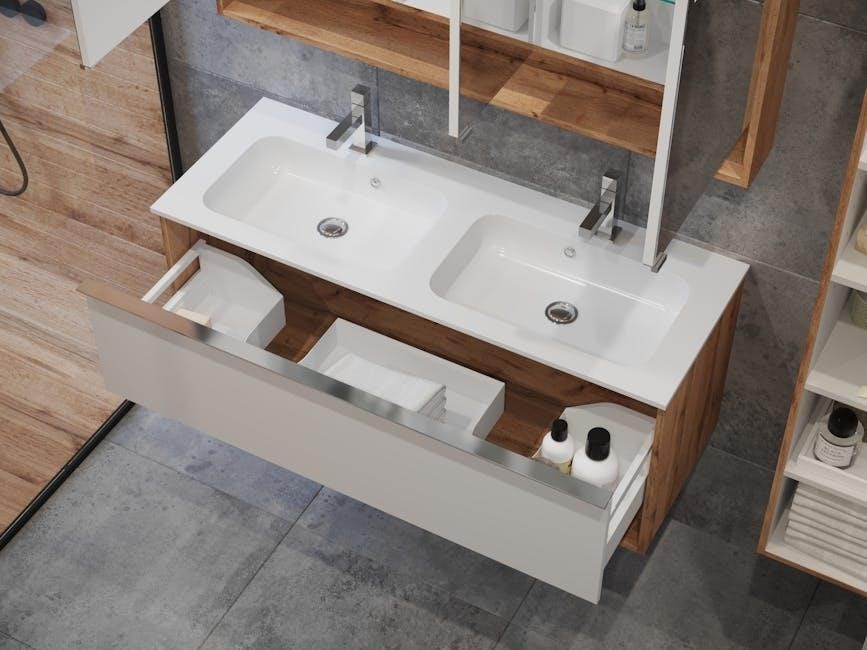A functional resume emphasizes skills, qualifications, and achievements over chronological work history, making it ideal for career changers, those with employment gaps, or entry-level candidates seeking to highlight versatility and adaptability.
Definition and Purpose
A functional resume is a resume format that emphasizes skills, qualifications, and achievements rather than chronological work history. It is designed to highlight transferable skills and experiences, making it particularly useful for individuals with non-traditional career paths, such as those with employment gaps, career changers, or entry-level candidates. The primary purpose of a functional resume is to showcase a candidate’s ability to perform a specific job by focusing on their expertise and accomplishments. This format allows job seekers to present their strengths effectively, even if their work history is inconsistent or unrelated to the target role. By organizing information around functional areas or key skills, the resume demonstrates how the candidate can contribute to the employer’s goals, regardless of their prior job titles or timelines. This approach is both strategic and adaptable, making it a powerful tool in certain job search scenarios.
Key Characteristics
A functional resume is characterized by its focus on skills, qualifications, and achievements rather than chronological work history. It typically includes sections such as “Key Skills,” “Functional Areas,” or “Achievements” that highlight the candidate’s expertise and versatility. This format often omits or minimizes detailed employment dates and job titles, making it ideal for individuals with gaps in employment, career changes, or limited work experience. The resume emphasizes transferable skills and experiences that align with the target job, allowing the candidate to showcase their ability to perform the desired role effectively. Additionally, functional resumes often use action verbs and quantifiable achievements to demonstrate impact and competence. This adaptable format is designed to present the candidate in the most favorable light, regardless of their career trajectory. By prioritizing relevance and capability, the functional resume serves as a strategic tool for job seekers aiming to stand out in competitive markets.
Benefits of Using a Functional Resume
A functional resume offers numerous benefits, particularly for individuals with non-traditional career paths. It effectively bridges employment gaps by focusing on skills and achievements rather than chronological work history. This format is ideal for career changers, as it highlights transferable skills and experiences relevant to the target role, showcasing versatility and adaptability. For entry-level candidates, it emphasizes abilities and potential over limited work experience. The functional resume also allows job seekers to tailor their application by aligning skills with the job description, making it easier for employers to recognize their qualifications. Additionally, it provides a clear and concise presentation of key strengths, helping candidates stand out in competitive job markets. Overall, this resume style is a powerful tool for presenting a candidate’s value and capabilities in a structured and impactful manner.

Who Should Use a Functional Resume
Individuals with employment gaps, career changers, and entry-level candidates benefit most from functional resumes, as they highlight skills and achievements over chronological work history.
Individuals with Employment Gaps
Functional resumes are particularly beneficial for individuals with employment gaps, as they shift focus from chronological work history to skills, qualifications, and achievements. This format allows job seekers to emphasize their strengths and relevant experience without drawing attention to periods of unemployment. For example, a stay-at-home parent re-entering the workforce or someone taking a career break can highlight transferable skills gained during their time away, such as volunteer work or freelance projects. By organizing the resume around functional areas rather than dates, individuals with gaps can present a cohesive and professional profile. Additionally, quantifiable achievements and measurable outcomes can demonstrate value, making the resume more compelling to employers. This approach helps bridge employment gaps effectively and ensures the candidate’s capabilities remain the focal point.
Career Changers
Functional resumes are an excellent choice for career changers, as they allow individuals to highlight transferable skills and experiences relevant to the new industry or role. By focusing on functional areas rather than a chronological work history, career changers can emphasize the skills they’ve developed in previous roles that align with the job they’re targeting. For example, a marketing professional transitioning to project management can showcase their organizational, leadership, and communication skills. This format helps bridge the gap between different industries or roles, making it easier for employers to see the candidate’s potential. Additionally, functional resumes enable career changers to present a clear and concise narrative, demonstrating how their past experiences prepare them for the new position. This approach maximizes the visibility of relevant qualifications, increasing the chances of securing an interview in a competitive job market.

Entry-Level Candidates
Functional resumes are highly beneficial for entry-level candidates, as they allow individuals to emphasize skills, education, and relevant experiences over limited work history. This format is particularly useful for recent graduates or those new to the workforce, as it highlights transferable skills gained through internships, volunteer work, or academic projects. By focusing on functional areas, entry-level candidates can demonstrate their potential and readiness for the role, even without extensive professional experience. For example, a recent graduate can showcase strong communication skills developed through group projects or leadership abilities honed in extracurricular activities. Functional resumes also provide an opportunity to tailor the content to the job description, making it easier for employers to see the candidate’s fit for the position. This approach helps level the playing field for entry-level candidates competing with more experienced applicants.

Functional Resume Structure and Examples
A functional resume emphasizes skills and experiences over chronological work history, ideal for showcasing transferable abilities. It typically includes sections like objective, key skills, professional experience, education, and additional information. Sample PDF templates demonstrate this clear, concise format, highlighting relevant skills and achievements. These examples provide a visual guide, helping job seekers present their qualifications effectively.
Overview of the Structure
A functional resume focuses on skills and qualifications rather than chronological work history, making it ideal for individuals with employment gaps or career transitions. It typically begins with a professional summary or objective, followed by a section highlighting key skills and qualifications. This is where transferable skills and relevant experiences are emphasized, showcasing the candidate’s ability to perform the job. The work experience section is often less detailed, emphasizing roles and achievements rather than dates. Education, certifications, and additional information like volunteer work or relevant projects are also included. The structure is designed to be clear and concise, allowing employers to quickly identify the candidate’s strengths. Sample PDF templates illustrate this format, providing a visual guide for job seekers to effectively present their qualifications. This structure helps candidates stand out by aligning their skills with the job requirements.
Sample PDF Templates
Functional resume sample PDF templates provide a visually structured format to showcase skills and qualifications effectively. These templates are designed to highlight transferable skills and relevant experiences, making it easier for employers to identify a candidate’s strengths. Many templates include sections for professional summaries, key skills, work experience, education, and additional information like certifications or volunteer work. PDF templates are popular because they maintain a professional appearance and consistent formatting, which is essential for making a strong first impression. Users can customize these templates to align with their specific job applications, ensuring the content is tailored to the role. Websites and resume builders offer a variety of free and paid functional resume PDF templates, catering to different industries and preferences. By using these templates, job seekers can present their qualifications in a clear and organized manner, increasing their chances of standing out to potential employers.
Real-Life Examples and Case Studies
Real-life examples and case studies demonstrate how functional resumes effectively highlight skills and experiences for job seekers. For instance, a career changer transitioning from retail to project management might emphasize transferable skills like team coordination and budgeting. A functional resume example for this individual would focus on relevant achievements rather than job titles. Similarly, a candidate with employment gaps might use a functional format to showcase volunteer work or freelance projects, proving their continued skill development. Case studies show that functional resumes can increase callback rates by up to 25% for candidates with non-traditional work histories. These examples illustrate how tailoring the resume to emphasize abilities over timelines can lead to successful job placements. By reviewing real-life scenarios, job seekers can better understand how to present their qualifications in a way that aligns with employer needs. This approach helps bridge gaps in employment or career transitions.

How to Tailor Your Functional Resume
Tailor your functional resume by aligning skills with job descriptions, emphasizing relevant abilities, and using action verbs to describe achievements. Quantify accomplishments to demonstrate impact clearly.
Identifying Relevant Skills
Identifying relevant skills is crucial when creating a functional resume. Start by analyzing the job description to pinpoint key qualifications and required abilities. Match these with your own skills, ensuring alignment with the role. Use specific keywords from the job posting to enhance relevance. Conduct a self-assessment to list your core competencies, such as communication, problem-solving, or leadership. Highlight transferable skills that apply across industries, like project management or data analysis. Organize these skills into clear categories, such as technical, interpersonal, or administrative abilities. Prioritize skills that demonstrate your value to the employer. For example, emphasize proficiency in software tools or languages if applying for a technical role. This targeted approach ensures your resume resonates with hiring managers and aligns with their needs.
- Analyze job descriptions for key qualifications.
- Match your skills with the job requirements.
- Use keywords to enhance relevance.
- Highlight transferable and industry-specific skills.
Highlighting Achievements
Highlighting achievements in a functional resume is essential to showcase your impact and value. Focus on specific accomplishments rather than duties, using action verbs like “developed,” “managed,” or “increased.” Quantify results by including numbers or percentages to demonstrate tangible outcomes. For example, “Improved project completion time by 25%” or “Led a team that achieved a 30% increase in sales.” Tailor these achievements to align with the job description, emphasizing skills and results relevant to the role. Use bullet points for clarity and readability. Organize achievements under functional categories, such as “Project Management” or “Customer Service.” Include any awards or recognition to further validate your expertise. By prioritizing results over responsibilities, you create a compelling narrative that highlights your ability to deliver results.
- Use action verbs to describe accomplishments.
- Quantify results with numbers or percentages.
- Align achievements with the job description.
- Organize achievements by functional categories.
Customization Tips

Customizing your functional resume is crucial to stand out in a competitive job market. Begin by carefully analyzing the job description and incorporating relevant keywords to align with the role. Tailor your skills section to emphasize abilities directly related to the position, ensuring they match the employer’s requirements. Use bullet points to present information clearly, making it easy for hiring managers to scan. Focus on adaptability, showcasing how your skills can be applied across different roles or industries; Avoid generic statements and instead, craft specific examples that demonstrate your versatility. For example, highlight transferable skills like “team leadership” or “problem-solving” if transitioning careers. Use action verbs consistently and ensure the resume is concise, avoiding unnecessary details. Finally, proofread to ensure clarity and professionalism, as a polished resume reflects attention to detail and dedication.
- Tailor skills to match job descriptions.
- Incorporate relevant keywords for ATS compatibility.
- Use bullet points for clear presentation.
- Highlight transferable skills for career transitions.
- Proofread for clarity and professionalism.

Tools and Resources
Utilize tools like Canva, LinkedIn’s Resume Builder, and downloadable PDF templates from Microsoft Word or Google Docs. Explore both free and premium options to create a polished functional resume sample PDF.

Resume Builders and AI Tools
Resume builders and AI tools are indispensable for crafting a functional resume sample PDF. Platforms like Canva, ResumeWorded, and LinkedIn’s Resume Builder offer intuitive interfaces to design professional layouts. AI tools, such as TopResume and Skillroads, analyze your content and suggest improvements to highlight skills and achievements. These tools often include templates tailored for functional resumes, emphasizing abilities over chronological work history. They also provide real-time feedback to optimize language and structure. For example, AI can identify weak phrases and recommend stronger alternatives, ensuring your resume stands out. Additionally, many tools allow exporting in PDF format, ensuring compatibility and a polished appearance. By leveraging these resources, you can create a compelling functional resume sample PDF that aligns with your career goals. Remember to customize the output to reflect your personal brand and the job requirements.
Downloadable Templates
Downloadable templates are a fantastic way to create a professional functional resume sample PDF. Websites like Microsoft Word Online, Google Docs, and Canva offer a wide range of free and premium templates designed specifically for functional resumes. These templates are structured to emphasize skills, qualifications, and achievements rather than chronological work history. Many templates are customizable, allowing you to replace placeholders with your personal information, ensuring a tailored fit for your experience. Some platforms, such as Etsy or Graphic River, provide unique, modern designs for a small fee. When using these templates, ensure the formatting remains clean and readable after customization. Always proofread your resume and consider using tools like Grammarly to check for errors. Downloadable templates simplify the process of creating a polished functional resume sample PDF, saving time and effort while maintaining professionalism.
Word and PDF Formats
When creating a functional resume sample PDF, it’s essential to consider the format. Microsoft Word (.docx) is ideal for editing and tailoring your resume, as it allows for easy customization of content and layout. Once finalized, converting your resume to a PDF format ensures consistency in appearance across all devices. PDFs are widely preferred by employers and applicant tracking systems (ATS) due to their professional presentation and inability to be accidentally altered. To convert your Word document to PDF, use built-in “Save As” options or online conversion tools. Ensure your PDF is properly named, such as “Your-Name-Functional-Resume.pdf,” for clarity. Additionally, check the file size to ensure it’s not excessively large, as this can cause issues during application submissions. Always proofread your resume before saving it as a PDF to maintain professionalism and avoid errors.
A well-crafted functional resume sample PDF can effectively highlight your skills and experiences, helping you stand out to employers. Always tailor it to the job and maintain professionalism.

Best Practices for Writing
When crafting a functional resume, prioritize clarity and relevance. Begin with a strong summary statement that highlights your core competencies. Focus on key skills and achievements, ensuring they align with the job requirements. Use specific examples to demonstrate your expertise, and quantify accomplishments where possible. Maintain a clean, professional format with bullet points for readability. Avoid jargon and keep language concise. Ensure your resume is tailored to the job description, emphasizing transferable skills. Include relevant sections like education and certifications, but keep the emphasis on functional capabilities. Proofread thoroughly to eliminate errors. Utilize action verbs to convey impact, and ensure consistency in formatting and style. By focusing on these elements, your functional resume will effectively showcase your value to potential employers.

Final Review and Proofreading
After drafting your functional resume, a thorough review and proofreading are essential to ensure professionalism and accuracy. Start by checking for grammar, spelling, and punctuation errors, as even minor mistakes can detract from your credibility. Use tools like Grammarly or ProWritingAid to identify and correct issues. Read the resume aloud to catch awkward phrasing or inconsistencies. Verify that all contact information, dates, and company names are accurate. Ensure the formatting is consistent, with uniform font styles, spacing, and bullet points. Double-check that all sections align with the job description. Finally, have a trusted friend or mentor review it for clarity and impact. A polished resume free of errors will make a strong impression and increase your chances of securing an interview.
Additional Resources
For further guidance on crafting an effective functional resume, explore additional resources such as career development books, online courses, and webinars. Websites like LinkedIn Learning and Coursera offer tutorials on resume writing and job search strategies. Professional associations often provide free resume guides tailored to specific industries. Additionally, many job search platforms, such as Indeed and Glassdoor, feature blogs with tips on optimizing your resume. Don’t hesitate to reach out to local libraries or career services for access to resume-building tools and expert advice. These resources can help refine your functional resume and improve your chances of standing out in a competitive job market. Utilize these tools to ensure your resume is polished, professional, and aligned with your career goals.
